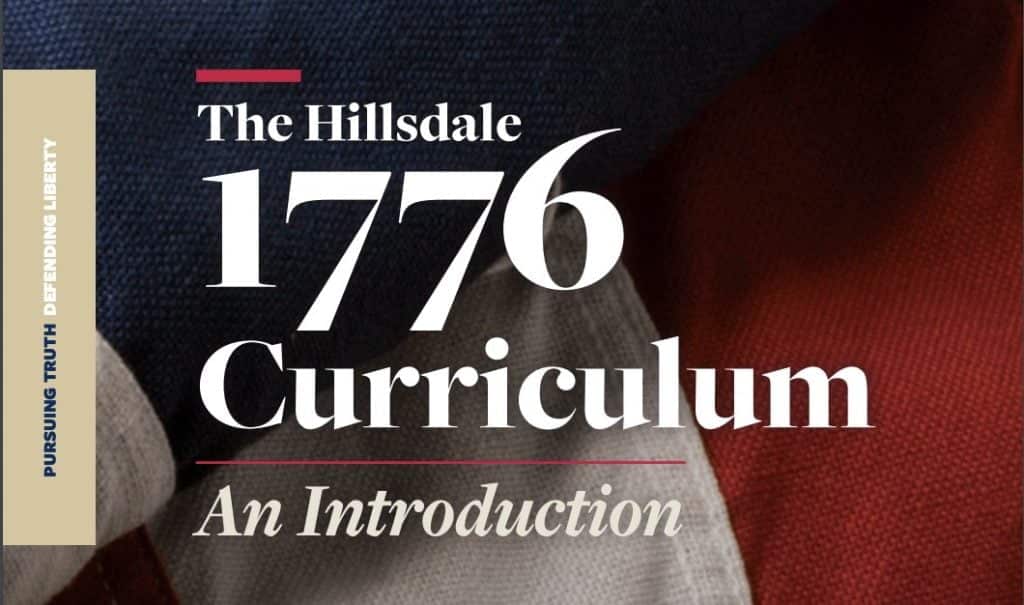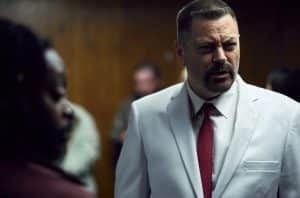In Pennridge School District, a Hillsdale alumni and his one man fledgling anti-woke consulting business Vermilion Education was recently hired by the far-right school board to help usher in the Hillsdale 1776 Curriculum and make it a required resource for 9th grade social studies teachers. I’ve taken some time to read through it so that you don’t have to. I’m going to make some general observations, then dig into a couple of specific units. This will take a while, so strap in.
Some basic takeaways
There’s not as much jaw-dropping bias as you think. Just a regular grade right-wing tilt. This matters because lots of civilians are going to look at this and think it doesn’t seem so bad. However, it is so bad.
It’s not really a curriculum, it’s more like a guide. And it fails to deliver much of what it promises.
The Hillsdale 1776 Curriculum is a complete collection of lesson plans for teaching American history, civics, and government to K-12 students.
Except it isn’t curriculum. Not even sort of. There are no standards attached. Lesson objectives use language that anyone with teacher training would avoid (“Students learn about etc…”).
It is undergirded with a belief in Truth, the notion that history is one single true narrative, a notion that bleeds through repeatedly, as when the guide refers to the “true story of history.” For instance, in describing the “harmonious” nature of a history and civics classroom:
“…sound history and civics classrooms will embrace an ordering and arranging of parts, just as the members of a symphony orchestra or athletic team move in complement to one another toward a common end [emphasis mine], led by a director or captain or coach.”
.Or from the “Dear Teacher” message about the basis for the “curriculum,” rooted in “truths which Hillsdale holds to be accessible to human reason, proven through the ages, and true of all people and all times.”
“That truth is objective, according to the first law of logic, the law of contradiction: that something cannot both be and not be at the same time in the same way. The first object of the human mind and the first end of education is this objective truth about the world.”
The guide offers units, broken into “lessons” that some number of classes, lists of sources, some “enduring ideas,” a list of stories to tell (but not the actual stories), questions to consider (Hillsdale’s “classical” approach is fond of Socratic questioning, which is a curious approach to take when you only recognize one right answer to anything), some “keys,” and some quizzes. Also carefully selected primary sources, because classical school people love those–as long as they’re the right ones.
In short, this curriculum is long on how, and short on what. If I were making my best guess, it would be that the “curriculum” here is what many teachers would recognize as the old “take this textbook and follow it” approach.
For the littles, Hillsdale likes Land of Hope: An Invitation to the Great American Story (Young Readers Edition), by Wilfred McClay, Professor of History and the Victor Davis Hanson Chair in Classical History and Western Civilization at Hillsdale College.
Land of Hope is published by Encounter Books, a conservative book company founded by the Bradley Foundation, a group excellent at funding the think tanks and university programs that provide this intellectual foundation for far-right policy ideas. When the book came out in 2019, conservative outlets praised it as an alternative. Here’s how National Review summed up the story of America conveyed in the book:
“They fought a revolution to preserve an existing culture of self-government and further distinguished themselves by proclaiming their shared ideals. They governed themselves under a Constitution designed to put those ideals into action. When tested by slavery, expansion, immigration, and the challenges of democracy, Americans made the constitutional order work. When their brethren rebelled in order to create a government on a different basis, Americans preserved the system of ordered liberty as understood by the Founders.”
There’s more, but you get the gist.
These threads run through the “curriculum.” American exceptionalism. The Constitution as holy writ. History as the story of individuals; but social forces, systems, none of that stuff matters. The constant challenge of people who want to overthrow the Constitution with “modern” ideas.
Nothing is really, truly up for discussion. Of course, traditional history texts also avoid any discussion topics by simply avoiding anything that is discussable and sticking to dates and simple accounts of events (which is why you remember high school history class as unspeakably dull). Hillsdale gets around the issue of discussion by operating on the belief that all history is settled, that there is one Truth, and that anyone who tells you otherwise is operating out of some sort of bias or attempt to push their unfounded agenda.
Of all the problematic parts of the Hillsdale guide, this is probably the worst – the idea that history is settled and set in stone, and that any attempt to suggest that it could be seen differently is just wrong. This is not doing history; it’s doing something else. History is a conversation, unending and always open to new discussion and insights. What Hillsdale is pushing is a completely other view of what history even is, a view that looks remarkably like indoctrination.
Okay, so what does all this look like in a specific example?
Some K-2 Units: British Colonies
Since I’m in daily contact with both someone who teaches 2nd graders and two small K-2 humans, I thought I’d look at what the guide offers. Turns out that this level is particularly weak.
READ: In Pennridge School District, Books Once Shadow Banned Are Now in the Trash Can
Unit 1 is the British Colonies of North America, broken into four lessons which are supposed to take up 35-39 lessons. One of the threads of Hillsdale’s program is a belief that geography is really important, so Lesson 1 focuses on that, on the advantages of the “virgin territory,” America’s excellent and untouched soil, though the indigenous tribes get a mention as well. “Explain how America is and has always been a land of immigrants,” it advises, noting that even the “native” people (the guide puts “native” in quotes) had probably immigrated from Asia. And also talk about Columbus “discovering” this “New World.”
Lesson 2 is exploration and settlement, abd is heavy on the economic and spiritual freedom aspect of settlement, while getting Winthrop’s City on a Hill in there to cue the exceptionalism. Teachers could ask students to compare current life to life prior to the 1600s, and not for the last time I’m wondering how many littles the writers know.
They would also like teachers to highlight that one motivation for founding Jamestown was “material opportunity for the lower classes.” This is the lesson that includes the one quote you may have already seen:
“Of particular note was Jamestown’s original experiment with a form of communism. This collectivism, plus rampant disease, helped produce a disastrous first year and a half for the fledgling settlement. John Smith’s requirement that settlers earn their bread by their work and his guarantee of private property ownership, along with some much-needed assistance from the local Native Americans, not only saved the settlement but also became quintessentially American traits, both in law and in the character of the people.”
Let me remind you again that this is the lesson for K-2 students. This stuff, too.
“Emphasize the English tradition of the rule of law and of forms of democratic expression traced back at least to the Magna Carta. Facing a lawless wilderness with families to protect and ex-convicts in their midst, the Pilgrims resorted to that English tradition of self-government under the rule of law—a social contract among themselves—with God as its ultimate judge.”
And this:
“Like the Pilgrims, these Puritans were fierce critics of the Church of England. Unlike the Pilgrims, however, the Puritans at Massachusetts Bay sought not to separate from the Church of England but to establish a community that would help purify and correct the Church of England while remaining a part of it. As evident in Winthrop’s ‘A Modell of Christian Charity,’ New England would convert Old England by its example.”
The writers are heavy on the self-governing part, and they also include other bits about religious dissent and “severe restrictions on religious belief,” but fail to mention that these restrictions were part of a complete lack of separation between church and state, much like the Puritans who executed Quakers caught proselytizing in Massachusetts. Certainly no hint that someone might have drawn some lessons about church-state separation from these.
READ: Pennridge School District Must Acknowledge Creationism Is Not Science
Lesson 3 is a look at colonies. Teachers are to emphasize that it was a Good Thing that the English government (the Dutch are left out of these accounts) stayed away and that neglect allowed colonies to be independent. Most colonies were private property ventures (you know–much better than government interference).
Spend time on what it meant to make a living and survive in the daunting wilderness and how such perseverance shaped the character and mind of the colonists. This would include looking at lifestyles and kinds of work done in the colonies and the type of self-reliance necessary for such lives.
No suggestions for addressing how such “self-reliance” might involve enslaved laborers helping you be self-reliant, but we are supposed to bring up the American character of “grit and determination.” There is some mention elsewhere in the lesson of slavery, mostly in the context of pointing out that indentured servants had it just as bad, and also slavery has been around through the whole history of the world. Relationships with the Native Americans? These, we are told, “ran the gamut from friendly to violent, varying widely depending on the tribe involved.” Apparently any problems were the fault of the natives.
And I know I already made this point, but I cannot get over the kind of instructions this guide provides for delivering lessons to 5-8 year olds.
Seriously.
“Emphasize with students the degree of self-government that the colonists exercised. Include in this discussion the meaning of self-government. In brief, the colonists largely governed their own internal affairs (rule over local matters, including taxation, as opposed to international trade and security) through local legislatures and governance structures chosen by the people. This was partly due to the English tradition of legislative authority and the rule of law, the loose and decentralized pattern of British colonial settlements and rule compared to other empires. Another factor at play here was the great distance between London and the American eastern seaboard, which led to long periods of “benign neglect” of the colonies and the further development of local institutions of self-government. While all of the colonies would eventually become official royal colonies with royal governors, colony-wide legislative bodies were prolific, as were local governments such as townships, counties, and cities.”
Lesson 4 is major colonial events. More about how British government neglect was “healthy for the colonists.” The lesson points out that the colonies weren’t regulated by a government, but of course they all had their own government which somehow counts as self-government, except when they begged the British for more help in governing the colonies and protecting them. And look, I’m not going to thrash this out here because the question of colonials’ ties to Britain was super-complicated and complex. But not in Hillsdale’s stuff.
READ: In Pennridge School District Where They Banned Banned Books Week, I Read as a Form of Protest
And here’s a new one – The Great Awakening provided the colonies “with something they could hold in common,” suggesting it helped pave the way for the Revolution. Except that it also happened in England, and many colonial churches split up over their feelings about this largely evangelical event.
The Unit comes with assessments, sort of, both for those who can read and write and those who can’t, though the reading and writing ones make some large demands. Some are very open-ended (“Tell me the story of the First Thanksgiving”), some are a little confusing (“What was daily life like for African colonists and African slaves?”), most assume the answer (“Why was it good that England did not pay the colonists much attention?”), and some are crazy wide open (“What were some of the lessons we can learn from the stories of the American colonists?”).
All assume that there’s just one correct way to view the events of history. If the classical education folks at Hillsdale want to foster critical thinking, this is surely not the way.
More K-2: Civil War
Look, I told you this would take a while. But I’ll try to briefer this time. Here’s one “enduring idea” from this unit.
That slavery was the original contradiction in America, and that slavery is immoral, unjust, dehumanizing, and in violation of the inherent dignity and equal possession of natural rights of each person, as are any ways in which one person or group of people is favored over another due to the color of their skin.
Got that? Slavery was bad, and so is that affirmative action reverse racism stuff.
Also, Lincoln was a great statesman who “ended the barbarous and tyrannical institution of slavery, and nevertheless abided by the rule of law in doing so.” So imposing the income tax to fund the war, and imposing a draft that struck some people as so awful that there were riots, and just generally exercising federal authority to an extent never before witnessed (suspension of habeas corpus, etc). Nothing complicated there.
Lesson 1 covers the expansion of slavery. Interesting twist – they talk about popular sovereignty defined not as the idea that power comes from the consent of the governed, but as the idea “that right and wrong are the mere will of the majority opinion.” Lincoln, they assert, knew better. There’s even an activity to drive home the point of majority tyranny. So remember, kids: Democracy is bad.
The outcome of the Civil War determined whether the nation would live according to the principles of liberty, equality under law, and self-government, or reject those truths in favor of slavery, inequality, and tyrannical rule.
Reconstruction is also covered. The Southern states, it turns out, were brought into the war through actions of their elite leaders, but two lessons later, Southern states are undoing civil rights for Blacks during Reconstruction.
Also, the Founders were against slavery and thought it would die out on its own. Definitely no more complicated issues to be touched on there (though in later grades, the guide does note that some founders held slaves).
Grades 9-12
While there is more ground to cover in the high school units, much of the language describing teacher focus and ideas and “keys to the lesson” are word for word the same as the K-2 units, almost as if this “curriculum” doesn’t differentiate all that much between students at different developmental levels.
The Revolutionary War unit hits on the idea that language in various documents, such as the Declaration of Independence, were consistent with the Christian tradition within which the American founding occurred. Other references to divine sources of truth in the Declaration include that men are “endowed by their Creator” and its appeals to “the Supreme Judge of the world” and to “the protection of divine Providence.”
When it comes to the Constitution, there’s a lot of talk about the Founders and the Framers as if they are a unified whole and not a cantankerous bunch of folks with serious disagreements. Do make sure they understand that it’s a Republic, not a Democracy, and point out early examples of majority tyranny, like debt cancellation by states. Also spend some time on the Electoral College and its purposeful creation to prevent fraudulent and tyrannical choices – but states “abandoned” that purpose when they tied the electoral college to popular votes.
There’s a lot about slavery and how the founders were really keen on getting rid of it eventually, because they were pretty sure that putting stuff in the Constitution would cause slavery to die out, which was better than losing the South. When we get to the Civil War, we’ll address the fact that the Founders got that totally wrong by blaming the cotton gin, which changed the whole nature of slavery by making it more profitable. You might think that’s an argument that the Constitution cannot simply be read by hewing to the Founders and ignoring the impact of changing times and contexts, but we’re surely not going there. Instead, we’ll argue that moral relativism, the idea that “might makes right,” and a belief in unfettered democracy through the vote of the majority were the slaveholders’ pillars in arguing to preserve slavery.
Abraham Lincoln was great because he realized that popular sovereignty (aka democracy) was bad, and so he stuck to the defense of objective standards of truth and justice, of good and evil.
This, as much as anything, is a critical piece of understanding the thinking on the right – a government does not derive legitimacy by the votes and support of citizens, but by aligning itself with what is True and Right – even if the majority of citizens disagree.
This, as much as anything in Hillsdale’s 1776, is a reason not to put this in schools – because it is working hard to lay a foundation for a rejection of democracy, to be replaced by rule of those who are sure they know what is Right and True.
And Federalist papers all day.
If you want more grades 9-12, how about civics?
There’s also a set of units for American Civics. There’s the Principles of America (liberty, equality, rights and self-government).
There’s a section about the Constitution and federalism that includes plenty about how limited a federal government is supposed to be, plus:
“The framers were very intentional about which level of government would have which powers based on a careful review of what each government’s purposes would be by nature.”
Which is kind of nuts because the framers could not agree about much of anything about the Constitution, and that’s on top of the fact that we say “framers” instead of “founders” because some of our founding fathers didn’t even want a Constitution in the first place (looking at you, Patrick “Give me liberty or give me death” Henry).
There’s a unit about Equality, and it’s as close as the guide comes to admitting that history is complicated. There’s this paragraph:
“So when the truth that slavery was present when the United States was being founded is set side-by-side with the truth that America was founded on the idea that ‘all men are created equal,’ judgements of hypocrisy at best and outright lying at worst are entirely expected. And such judgments were made at the time of the founding as they are made today. By themselves, these two facts can only lead to these two conclusions.”
READ: Pennridge Diversity Meeting Meltdown Demonstrates Why DEI Is Desperately Needed
Oh, but then this line comes next:
“And yet, these facts do not stand by themselves.”
Everybody was doing it, in every country, since the dawn of time. But we at least argued about it and some of us felt bad about it and eventually shot each other over it and meanwhile “peoples across the world turned to America and its founding principle of equality to end tyrannies, colonization, and other injustices.”
Nobody else in the world is founded on “all men are created equal.” When Martin Luther King Jr. talked about the “promissory note” that we didn’t deliver on, that actually shows how exceptional and great we were to make the promise in the first place, even if we didn’t keep it. But, the guide warns, be careful with “consider the times” as that might give the impression that truth and morality are relative to time and place and not immutable Truth.
There’s a unit about Progressivism. Spoiler alert: it was and is bad.
It denies objective Truth. It supports government doing a bunch of stuff – the administrative state. Not saying that stuff is wrong, but it goes against the Constitution, which is codified to fit absolute Truth. So there are “philosophical differences” between Progressives and “the founding.”
There’s a unit about late-20th century that includes lessons about the civil rights movement which try very hard to parse the difference between demanding that the law treat all persons equally and demanding some larger levels of justice that involve noticing someone’s race. The term “color blind” isn’t much used, but it might as well be plastered all over the pages.
There are lessons about other new philosophies like the New Left, but first a reminder for students:
“Ask students to consider once more the claims to objective truth and objective morality on which the American regime rests. On one hand, thinkers in the West since ancient times had seen in nature and in human nature a basic objective reality that the human mind is capable of recognizing and understanding, and upon which government could be based. On the other hand, the founders also argued for the existence of an objective human good, something toward which all human actions should aim and in light of which human beings should act freely in the pursuit of their happiness, but which government had no power to control unless a pursuit violated the natural rights of an individual. It is important to review both of these facets to truth and morality as they relate to establishing self-government and to what a government may and may not do. Many critiques in the late 20th century challenged these presumptions.”
READ: The Bucks County Courier Times Fails Readers With Its Book (Banning) Policy Editorial
In short, we’ve known what is True since ancient times, therefore anything new is probably wrong. New rights like privacy and self-expression? Liberation and social justice? Affirmative action? That’s all looking pretty shady.
Are you still here?
God bless you. I’ll try to wrap it up.
Again, if you’re scanning the Hillsdale “curriculum” for the kind of jaw-dropping crazy-pants stuff you’d expect from a rogue MAGA tool, you won’t find it. What you do find is a thorough laying out of the conservative view of US history, based on some premises that I would deem dubious.
There is objective and immutable truth, and wise people have reasoned it out since ancient times. Our founders and framers knew that Truth and wrote it into a Constitution. Our government gets its legitimacy from adherence to those Truths and not from any tyranny of the majority. In fact, every time this nation has ever messed up, it has been because too many voters and powerful people ignored those Truths.
As an actual curriculum, 1776 is not particularly well-crafted, developmentally appropriate, thorough, complete, or well, good. As an attempt to create and transmit the right wing argument against democracy in general and our country’s history in particular, it’s coherent, consistent, and it absolutely indoctrinates. No public school in this country should be using it, or anything built on top of it.
This was originally published at the progressive education blog Curmudgucation, and was lightly edited.







